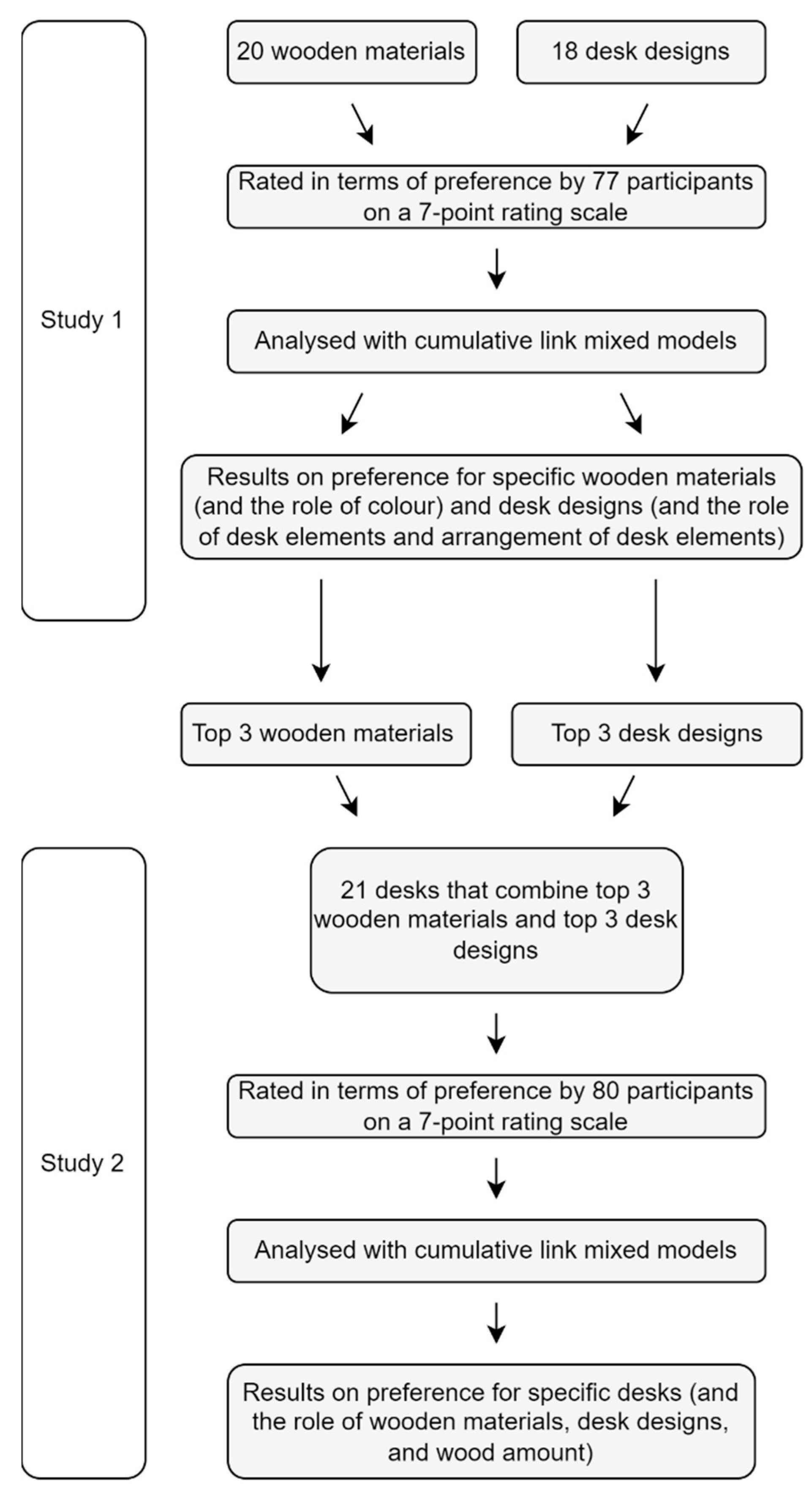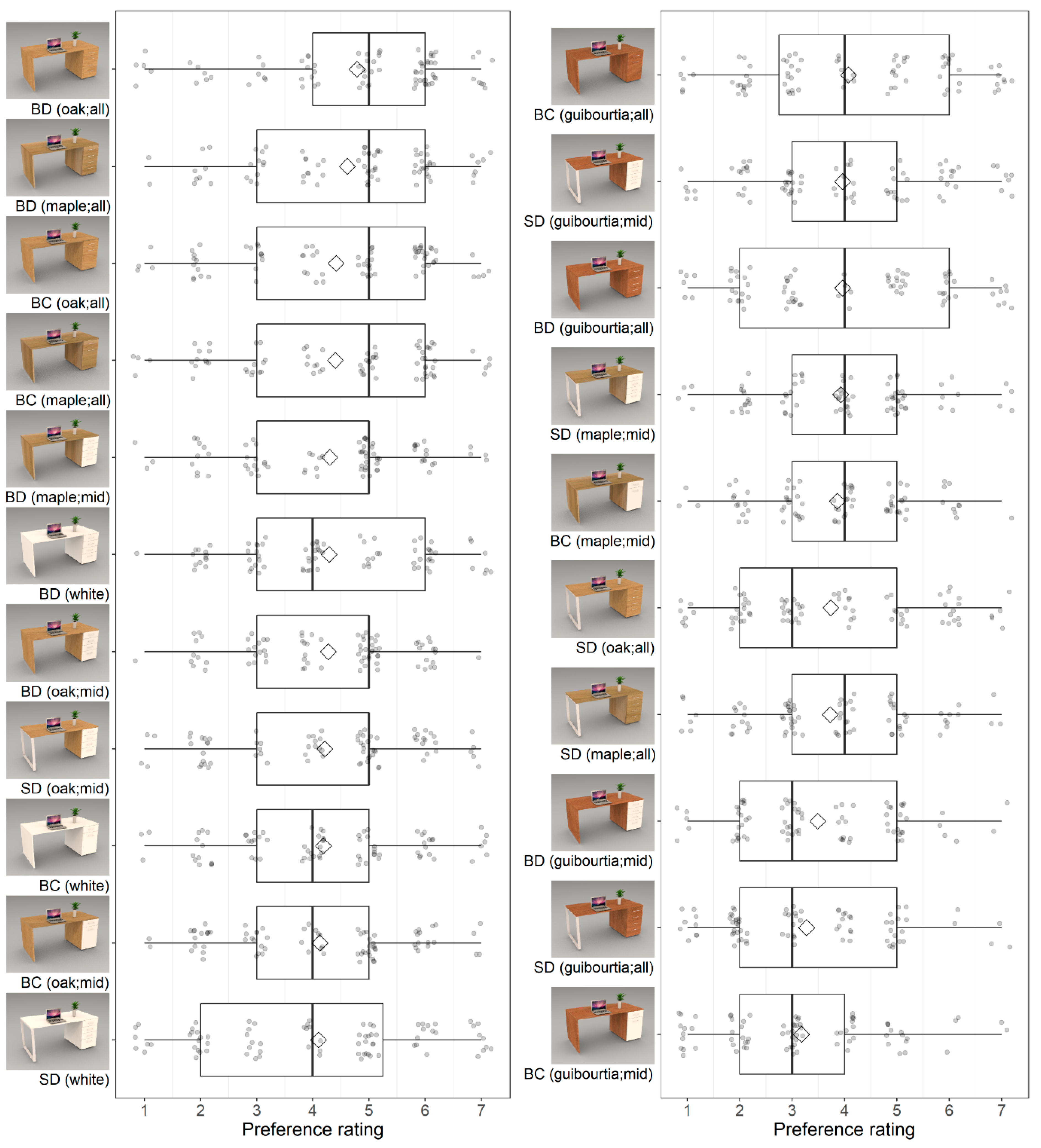Human Preferences for the Visual Appearance of Desks: Examining the Role of Wooden Materials and Desk Designs
Abstract
1. Introduction
2. Study 1
2.1. Materials and Methods
2.1.1. Wooden Materials
2.1.2. Desk Designs
2.1.3. Survey
2.1.4. Participants
2.1.5. Statistical Analysis
2.2. Results
2.2.1. Wooden Materials
Preference for Wooden Materials
The Role of Wood Colour in Preferences for Wooden Materials
2.2.2. Preference for Desk Designs
2.2.3. The Role of the Arrangement of Desk Elements in Preference for Desk Designs
2.2.4. The Role of Individual Desk Elements in Preference for Desk Designs
The Role of Desk Elements within Both-Storage Desks
The Role of Desk Elements within Both-Stand Desks
The Role of Desk Elements within One-Stand-One-Storage Desks
2.3. Discussion
2.3.1. Preference for Wooden Materials
2.3.2. Preference for Desk Designs
3. Study 2
3.1. Materials and Methods
3.1.1. Desks with Different Designs and Types and Amounts of Wood
3.1.2. Survey
3.1.3. Participants
3.1.4. Statistical Analysis
3.2. Results
3.2.1. Preference for Desks
3.2.2. The Role of Material and Desk Design in Preference
3.2.3. The Role of Wood Amount in Preference
3.3. Discussion
4. General Discussion
5. Limitations
6. Summary and Conclusions
Supplementary Materials
Author Contributions
Funding
Data Availability Statement
Acknowledgments
Conflicts of Interest
References
- Gillis, K.; Gatersleben, B. A Review of Psychological Literature on the Health and Wellbeing Benefits of Biophilic Design. Buildings 2015, 5, 948–963. [Google Scholar] [CrossRef]
- Mcsweeney, J.; Rainham, D.; Johnson, S.A.; Sherry, S.B.; Singleton, J. Indoor nature exposure (INE): A health-promotion framework. Health Promot. Int. 2015, 30, 126–139. [Google Scholar] [CrossRef] [PubMed]
- Kaplan, S. The Restorative Benefits of Nature: Toward an Integrative Framework. J. Environ. Psychol. 1995, 15, 169–182. [Google Scholar] [CrossRef]
- Danna, K.; Griffin, R.W. Health and well-being in the workplace: A review and synthesis of the literature. J. Manag. 1999, 25, 357–384. [Google Scholar] [CrossRef]
- Al Horr, Y.; Arif, M.; Kaushik, A.; Mazroei, A.; Katafygiotou, M.; Elsarrag, E. Occupant productivity and office indoor environment quality: A review of the literature. Build. Environ. 2016, 105, 369–389. [Google Scholar] [CrossRef]
- Van den Berg, A.E.; Koole, S.L.; Van der Wulp, N.Y. Environmental preference and restoration: (How) are they related? J. Environ. Psychol. 2003, 23, 135–146. [Google Scholar] [CrossRef]
- Hartig, T.; Staats, H. The need for psychological restoration as a determinant of environmental preferences. J. Environ. Psychol. 2006, 26, 215–226. [Google Scholar] [CrossRef]
- Burnard, M.D.; Nyrud, A.Q.; Bysheim, K.; Kutnar, A.; Vahtikari, K.; Hughes, M. Building material naturalness: Perceptions from Finland, Norway and Slovenia. Indoor Built. Environ. 2017, 26, 92–107. [Google Scholar] [CrossRef]
- Rice, J.; Kozak, R.A.; Meitner, M.J.; Cohen, D.H. Appearance Wood Products and Psychological Well-Being. Wood Fiber Sci. 2006, 38, 644–659. [Google Scholar]
- Lipovac, D.; Burnard, M.D. Effects of visual exposure to wood on human affective states, physiological arousal and cognitive performance: A systematic review of randomized trials. Indoor Built. Environ. 2020, 30, 1021–1041. [Google Scholar] [CrossRef]
- Shen, J.; Zhang, X.; Lian, Z. Impact of Wooden Versus Nonwooden Interior Designs on Office Workers’ Cognitive Performance. Percept. Mot. Skills 2020, 127, 36–51. [Google Scholar] [CrossRef]
- Burnard, M.D.; Kutnar, A. Human stress responses in office-like environments with wood furniture. Build Res. Inf. 2020, 48, 316–330. [Google Scholar] [CrossRef]
- Burnard, M.D.; Kutnar, A. Wood and human stress in the built indoor environment: A review. Wood Sci. Technol. 2015, 49, 969–986. [Google Scholar] [CrossRef]
- Nyrud, A.Q.; Bringslimark, T. Is interior wood use psychologically beneficial? A review of psychological responses toward wood. Wood Fiber Sci. 2010, 42, 202–218. [Google Scholar]
- Bamba, I.; Azuma, K. Psychological and Physiological Effects of Japanese Cedar Indoors after Calculation Task Performance. J. Hum. Environ. Syst. 2015, 18, 33–41. [Google Scholar] [CrossRef]
- Lipovac, D.; Podrekar, N.; Burnard, M.D.; Šarabon, N. Effect of desk materials on affective states and cognitive performance. J. Wood Sci. 2020, 66, 43. [Google Scholar] [CrossRef]
- Zhang, X.; Lian, Z.; Ding, Q. Investigation variance in human psychological responses to wooden indoor environments. Build. Environ. 2016, 109, 58–67. [Google Scholar] [CrossRef]
- Tsunetsugu, Y.; Yoshifumi, M.; Sato, H. Visual effects of interior design in actual-size living rooms on physiological responses. Build. Environ. 2005, 40, 1341–1346. [Google Scholar] [CrossRef]
- Tsunetsugu, Y.; Miyazaki, Y.; Sato, H. Physiological effects in humans induced by the visual stimulation of room interiors with different wood quantities. J. Wood Sci. 2007, 53, 11–16. [Google Scholar] [CrossRef]
- Ikei, H.; Song, C.; Miyazaki, Y. Physiological effects of touching wood. Int. J. Environ. Res. Public Health 2017, 14, 801. [Google Scholar] [CrossRef]
- Ikei, H.; Song, C.; Miyazaki, Y. Physiological effects of touching hinoki cypress (Chamaecyparis obtusa). J. Wood Sci. 2018, 64, 226–236. [Google Scholar] [CrossRef]
- Sakuragawa, S.; Miyazaki, Y.; Kaneko, T.; Makita, T. Influence of wood wall panels on physiological and psychological responses. J. Wood Sci. 2005, 51, 136–140. [Google Scholar] [CrossRef]
- Loredan, N.P.; Lipovac, D.; Jordan, S.; Burnard, M.D.; Šarabon, N. Thermal effusivity of different tabletop materials in relation to users’ perception. Appl. Ergon. 2022, 100, 103664. [Google Scholar] [CrossRef] [PubMed]
- Høibø, O.; Nyrud, A.Q. Consumer perception of wood surfaces: The relationship between stated preferences and visual homogeneity. J. Wood Sci. 2010, 56, 276–283. [Google Scholar] [CrossRef]
- Nyrud, A.Q.; Roos, A.; Rødbotten, M. Product attributes affecting consumer preference for residential deck materials. Can. J. For. Res. 2008, 38, 1385–1396. [Google Scholar] [CrossRef]
- Lipovac, D.; Burnard, M.D.; Sandak, A.; Sandak, J. Wood protection techniques and natural weathering: Their effect on aesthetics and preference of people. In Proceedings of the IRG Annual Meeting, Quebec City, QU, Canada, 12–16 May 2019; The International Research Group on Wood Protection: Stockholm, Sweden, 2019. [Google Scholar]
- Fujisaki, W.; Tokita, M.; Kariya, K. Perception of the material properties of wood based on vision, audition, and touch. Vision Res. 2015, 109, 185–200. [Google Scholar] [CrossRef]
- Lipovac, D.; Wie, S.; Nyrud, A.Q.; Burnard, M.D. Perception and evaluation of (modified) wood by older adults from Slovenia and Norway. Wood Fiber Sci. 2022, 54, 45–59. [Google Scholar] [CrossRef]
- Openshaw, S.; Taylor, E. Ergonomics and Design: A Reference Guide; Allsteel Inc.: Muscatine, IA, USA, 2006. [Google Scholar]
- Nyrud, A.Q.; Bringslimark, T.; Bysheim, K. Benefits from wood interior in a hospital room: A preference study. Archit. Sci. Rev. 2014, 57, 125–131. [Google Scholar] [CrossRef]
- Fell, D.R. Restorative Properties of Wood in the Built Indoor Environment. Ph.D. Thesis, The University of British Columbia, Vancouver, BC, Canada, 2010. [Google Scholar] [CrossRef]
- Zhang, X.; Lian, Z.; Wu, Y. Human physiological responses to wooden indoor environment. Physiol. Behav. 2017, 174, 27–34. [Google Scholar] [CrossRef]
- Demattè, M.L.; Zucco, G.M.; Roncato, S.; Gatto, P.; Paulon, E.; Cavalli, R.; Zanetti, M. New insights into the psychological dimension of wood–human interaction. Eur. J. Wood Wood Prod. 2018, 76, 1093–1100. [Google Scholar] [CrossRef]
- Nakamura, M.; Ikei, H.; Miyazaki, Y. Physiological effects of visual stimulation with full-scale wall images composed of vertically and horizontally arranged wooden elements. J. Wood Sci. 2019, 65, 55. [Google Scholar] [CrossRef]
- Bhatta, S.R.; Tiippana, K.; Vahtikari, K.; Hughes, M.; Kyttä, M. Sensory and emotional perception of wooden surfaces through fingertip touch. Front. Psychol. 2017, 8, 367. [Google Scholar] [CrossRef] [PubMed]
- Manuel, A.; Leonhart, R.; Broman, O.; Becker, G. Consumers’ perceptions and preference profiles for wood surfaces tested with pairwise comparison in Germany. Ann. For. Sci. 2015, 72, 741–751. [Google Scholar] [CrossRef]
- Overvliet, K.E.; Soto-Faraco, S. I can’t believe this isn’t wood! An investigation in the perception of naturalness. Acta Psychol. AMST 2011, 136, 95–111. [Google Scholar] [CrossRef] [PubMed]
- SketchUp Make. Available online: https://www.sketchup.com/ (accessed on 20 May 2021).
- Raylectron 4. Available online: https://raylectron.com/webver2/ (accessed on 20 May 2021).
- 1KA. Available online: www.1ka.si (accessed on 10 June 2021).
- Ooms, J. Magick: Advanced Graphics and Image-Processing in R. Available online: https://cran.r-project.org/package=magick (accessed on 20 December 2021).
- R Studio Team. R: A Language and Environment for Statistical Computing; R Foundation for Statistical Computing: Vienna, Austria, 2021; Available online: https://www.r-project.org/ (accessed on 14 December 2021).
- R Studio Team. RStudio: Integrated Development Environment for R; R Foundation for Statistical Computing: Vienna, Austria, 2021; Available online: https://www.rstudio.com/ (accessed on 14 December 2021).
- Kassambara, A. Rstatix: Pipe-Friendly Framework for Basic Statistical Tests; R Package Version 0.7.0; R Foundation for Statistical Computing: Vienna, Austria, 2020; Available online: https://cran.r-project.org/package=rstatix (accessed on 14 December 2021).
- Christensen, R.H.B. Ordinal-Regression Models for Ordinal Data; R Package Version 2019.12-10; R Foundation for Statistical Computing: Vienna, Austria, 2019. [Google Scholar]
- Lenth, R.V. Emmeans: Estimated Marginal Means, Aka Least-Squares Means. Available online: https://github.com/rvlenth/emmeans (accessed on 16 December 2021).
- Barthelme, S. Imager: Image Processing Library Based on ‘CImg’; R Package Version 0.42.11; R Foundation for Statistical Computing: Vienna, Austria, 2023; Available online: https://cran.r-project.org/package=imager (accessed on 20 December 2021).
- Weller, H. Colordistance: Distance Metrics for Image Color Similarity; R Foundation for Statistical Computing: Vienna, Austria, 2021; Available online: https://cran.r-project.org/package=colordistance (accessed on 20 December 2021).
- Davis, G. SpacesXYZ: CIE XYZ and Some of Its Derived Color Spaces; R Package Version 1.1-1. Available online: https://cran.r-project.org/package=spacesXYZ (accessed on 20 December 2021).
- Gohel, D. Flextable: Functions for Tabular Reporting. Available online: https://cran.r-project.org/package=flextable (accessed on 23 December 2021).
- Wilke, C.O. ggtext: Improved Text Rendering Support for ggplot2. Available online: https://wilkelab.org/ggtext/ (accessed on 23 December 2021).
- Auguie, B. GridExtra: Miscellaneous Functions for ‘Grid’ Graphics; R Package Version 2.3; R Foundation for Statistical Computing: Vienna, Austria, 2017; Available online: https://cran.r-project.org/package=gridExtra (accessed on 23 December 2021).
- Wickham, H.; Averick, M.; Bryan, J.; Chang, W.; McGowan, L.D.; François, R.; Grolemund, G.; Hayes, A.; Henry, L. Welcome to the {tidyverse}. J. Open Source Softw. 2019, 4, 1–6. [Google Scholar] [CrossRef]
- DeltaE Function—RDocumentation. Available online: https://www.rdocumentation.org/packages/spacesXYZ/versions/1.1-1/topics/DeltaE (accessed on 21 January 2022).
- Hunt, R.W. The Reproduction of Colour, 6th ed.; John Wiley & Sons: Chichester, UK, 2004. [Google Scholar] [CrossRef]
- Weller, H. Introduction [to the Colordistance R. Package]; R Foundation for Statistical Computing: Vienna, Austria, 2021; Available online: https://cran.r-project.org/web/packages/colordistance/vignettes/colordistance-introduction.html (accessed on 21 January 2022).
- Rubner, Y.; Tomasi, C.; Guibas, L.J. Earth mover’s distance as a metric for image retrieval. Int. J. Comput. Vis. 2000, 40, 99–121. [Google Scholar] [CrossRef]
- Clmm Function—RDocumentation. Available online: https://www.rdocumentation.org/packages/ordinal/versions/2019.12-10/topics/clmm (accessed on 21 January 2022).
- Tutz, G.; Hennevogl, W. Random effects in ordinal regression models. Comput. Stat. Data Anal. 1996, 22, 537–557. [Google Scholar] [CrossRef]
- Liou, P.Y.; Bulut, O. The Effects of Item Format and Cognitive Domain on Students’ Science Performance in TIMSS 2011. Res. Sci. Educ. 2020, 50, 99–121. [Google Scholar] [CrossRef]





Disclaimer/Publisher’s Note: The statements, opinions and data contained in all publications are solely those of the individual author(s) and contributor(s) and not of MDPI and/or the editor(s). MDPI and/or the editor(s) disclaim responsibility for any injury to people or property resulting from any ideas, methods, instructions or products referred to in the content. |
© 2023 by the authors. Licensee MDPI, Basel, Switzerland. This article is an open access article distributed under the terms and conditions of the Creative Commons Attribution (CC BY) license (https://creativecommons.org/licenses/by/4.0/).
Share and Cite
Lipovac, D.; Burnard, M.D. Human Preferences for the Visual Appearance of Desks: Examining the Role of Wooden Materials and Desk Designs. Buildings 2023, 13, 1680. https://doi.org/10.3390/buildings13071680
Lipovac D, Burnard MD. Human Preferences for the Visual Appearance of Desks: Examining the Role of Wooden Materials and Desk Designs. Buildings. 2023; 13(7):1680. https://doi.org/10.3390/buildings13071680
Chicago/Turabian StyleLipovac, Dean, and Michael D. Burnard. 2023. "Human Preferences for the Visual Appearance of Desks: Examining the Role of Wooden Materials and Desk Designs" Buildings 13, no. 7: 1680. https://doi.org/10.3390/buildings13071680
APA StyleLipovac, D., & Burnard, M. D. (2023). Human Preferences for the Visual Appearance of Desks: Examining the Role of Wooden Materials and Desk Designs. Buildings, 13(7), 1680. https://doi.org/10.3390/buildings13071680







